Understanding the Lithium market
Over time, lithium has risen as one of the most crucial commodities of the decade, with more and more investors paying heightened attention to significant shifts in the energy and battery sector, transitioning from fossil fuels and combustion engines to lithium-ion-batteries requires vast amounts of battery metals. In this article, The Assay will break down the lithium market and help readers understand what opportunities lie ahead for the material.
Overall, lithium is a soft, silvery white, alkali metal with the lowest density of all metals. It is highly reactive when it encounters water. As a battery metal, lithium is predominantly recognized for being the principal components of rechargeable lithium-ion batteries and is frequently utilized in many industries.
Uses of lithium in industry
Batteries for electric vehicles
With governments shifting their policies to decarbonize transportation sectors, the global lithium market, particularly lithium-ion batteries in electric vehicles (EVs), have exploded and facilitated a drastic rise in price for lithium. According to Nissan, Lithium-ion batteries have elevated energy densities in comparison to lead-acid batteries or nickel-metal hydride batteries, so the battery size can be made smaller whilst still retaining the same storage capacity. EVs don’t use a single battery like a phone. Instead, they utilize a pack of batteries which comprise thousands of individual li-ion cells.
Automakers are pouring billions into electrification and the lithium market, with the goal that the future generation of EVs will be cleaner and more efficient than their gas-powered predecessors.
Batteries for other technologies
In a report produced by the United States Geological Survey (USGS), in the late 20th century, lithium became an anode material for lithium batteries, since 2007 it has maintained a sizeable market. Lithium is most commonly used to power laptop computers, mobile phones, cordless heavy-duty power tools, and hand-held electronic devices.
Over the years, lithium consumption for batteries has significantly increased as technologies have evolved, particularly because rechargeable lithium batteries are broadly utilized in the substantial market for portable electronic devices and are more progressively being used in electric tools, electric vehicles, and grid storage applications.
Lithium used in conventional batteries remains a dominant market, with stable growth and demand.
Metallurgy
According to the Royal Society of Chemistry, one of the principal uses for lithium is to develop alloys. When combined with aluminium and magnesium, alloys are produced, possessing lower density and higher levels of strength.
How is lithium mined
Evaporation pond mining
A overriding proportion of the world’s lithium is extracted from a mineral-rich brine beneath the aqueous lakes of high-altitude salt flats.
Lithium is obtained by drilling down through the Earth’s crust and then pushing the brine up to the surface into large evaporation ponds. Over a long period of time, a salty sludge comprising a mixture of lithium salts, borax, manganese, and potassium is produced, which is then moved to an additional evaporation pond. After an estimated 12-18 months, the mixture is refined to isolate the lithium carbonate, the main raw material used in lithium-ion batteries.
This technique of mining is frequently used in the South American Lithium Triangle which connects Bolivia, Chile, and Argentina. It is favourable amongst international lithium miners due to its low cost and efficiency in extracting lithium carbonate. However, the process is extremely water rigorous.
Some lithium companies have shifted their attention to more sustainable mining practices within the lithium mining industry. Lake Resources (ASX: LKE | OTC: LLKKF) for instance, is focused on developing the Kachi Lithium project in Argentina, South America, – within the “Lithium Triangle” – stating its “Lilac” direct lithium extraction technology will use vastly less water, less CO2, and less land – leaving a much smaller environmental footprint.
Hard rock mining
An alternative method of lithium extraction is through hard rock mining. Hard rock mining describes the process of extracting lithium, predominantly spodumene, from pegmatite deposits. Once the ores are extracted, they are then crushed and separated to produce a concentrate, this is then sold to lithium hydroxide or carbonate conversion plants, predominantly in Asia.
Hard rock VS brine
According to S&P Market Intelligence, hard rock mining is considerably less costly than brine mining. The company’s report estimates that hard rock mining costs less than half the price to produce lithium than evaporation pond methods.
The company reported that in 2019, the average total cost amongst 11 operational hard-rock manufacturers was estimated to be US$2,540/t lithium-carbonate equivalent (LCE), compared to US$5,580/t LCE across nine brine operations. This analysis is expressed in the graph below:
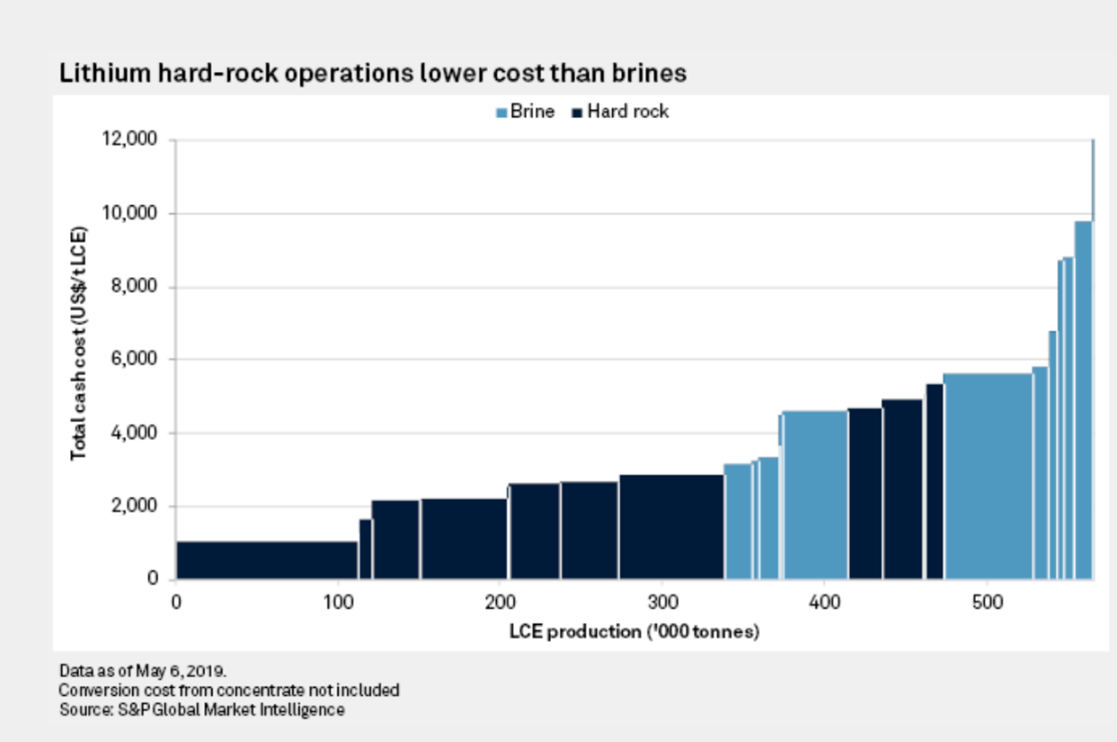
Nevertheless, the report also states that despite hard-rock producers maintaining reduced costs, the price the companies receive for the spodumene concentrate, is substantially less than that received for lithium carbonate, chloride, and hydroxide, which are produced at brine operations. The graph below expresses the variations in price depending on the end product of either hard rock or brine mining.
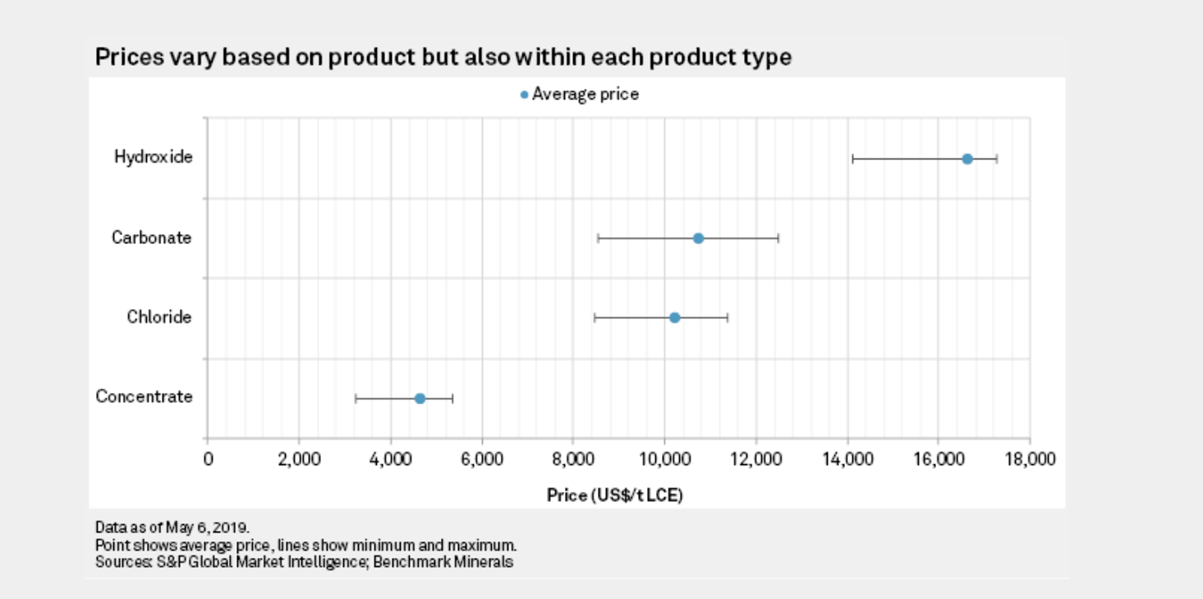
Lithium demand
Recent statistics published by the Australian government show that demand growth for lithium is continuing to rise. According to the government’s data, the principal growth in demand has been propelled by a combination of rechargeable batteries, for electronic devices and more significantly, electric vehicles.
Demand for lithium in the electric vehicles sector is forecast to grow swiftly as major car manufacturers are more consistently investing time and strategies into sourcing new models in order to secure a significant market share. According to Statista, in 2030, global demand for lithium is projected to exceed two million metric tons of lithium carbonate equivalent (LCE), which according to their report is more than double the demand forecast for 2025.
Combined with the demand for electric vehicles, various government subsidies and legislation are shifting their primary focus from fossil fuels, to promoting cleaner environmental alternatives are also anticipated guide consumers into transitioning to hybrid or electric vehicles.
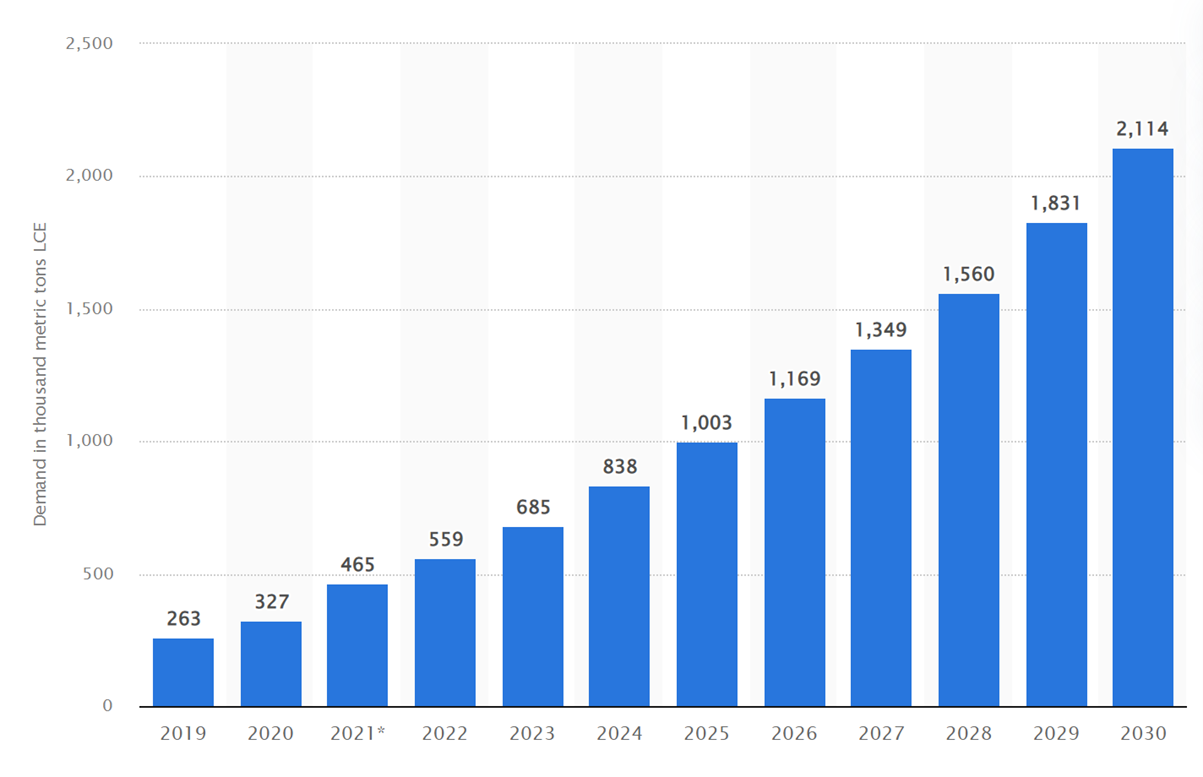
Demand triggered by government legislation is particularly emphasized in Europe, where increasing green policy rulings are being made in order to combat the growing pressures of CO2 emissions. Another reason for demand peaking in Europe is because some of the world’s mostsignificant car manufacturers are based in the continent, most of who are fighting to combat the supply pressures the electric vehicle market has generated.
One significant factor to consider when analysing lithium demand forecasts is the rise in alternative, cheaper battery metals, which car manufacturers are snapping up to meet global demands. Recently, new scientific breakthroughs have captured battery developers’ attention in the possibility of zinc as a key component in energy storage technology which could be a potential replacement for lithium.
According to a report by Chemical and Engineering News, zinc is compatible with aqueous electrolytes, is low-costing and is possibly a safer option for rechargeable batteries than lithium due to its level of stability when in air, which typically use flammable organic electrolytes.
New attention paid to alternative battery materials for EVs is a variable to consider when contemplating future demand for lithium.
Lithium supply
Analysts at S&P Global expect that new lithium mines, alongside increased production from numerous existing projects, will trigger global lithium production by 2025 to reach above an estimated 1.5Mt on a “lithium carbonate equivalent (LCE) basis” Experts are asking, however, if this is enough.
The continuing unparalleled demand for lithium, predominantly due to the growth of the EV market, has sparked questions of international supply shortages. The lithium industry is wrought with limited supply capacities, which pose a direct threat to the global prerogative to achieve a net-zero status in the coming years, particularly in the automotive sector.
According to Australia’s Department of Industry, worldwide production of LCE was estimated in December 2021 at 485,000t in 2021, growing to 615,000t in 2022 and 821,000t in 2023. This growth suggests that despite substantial surges in lithium production, there will still be a considerable supply deficit by 2030. Furthermore, Statista released a report predicting that by 2030, the global demand for lithium will surpass 2Mtof LCE, more than doubling the demand forecast for 2025, exceeding current worldwide resources. This deficit can be viewed in the chart below, provided by S&P Global.
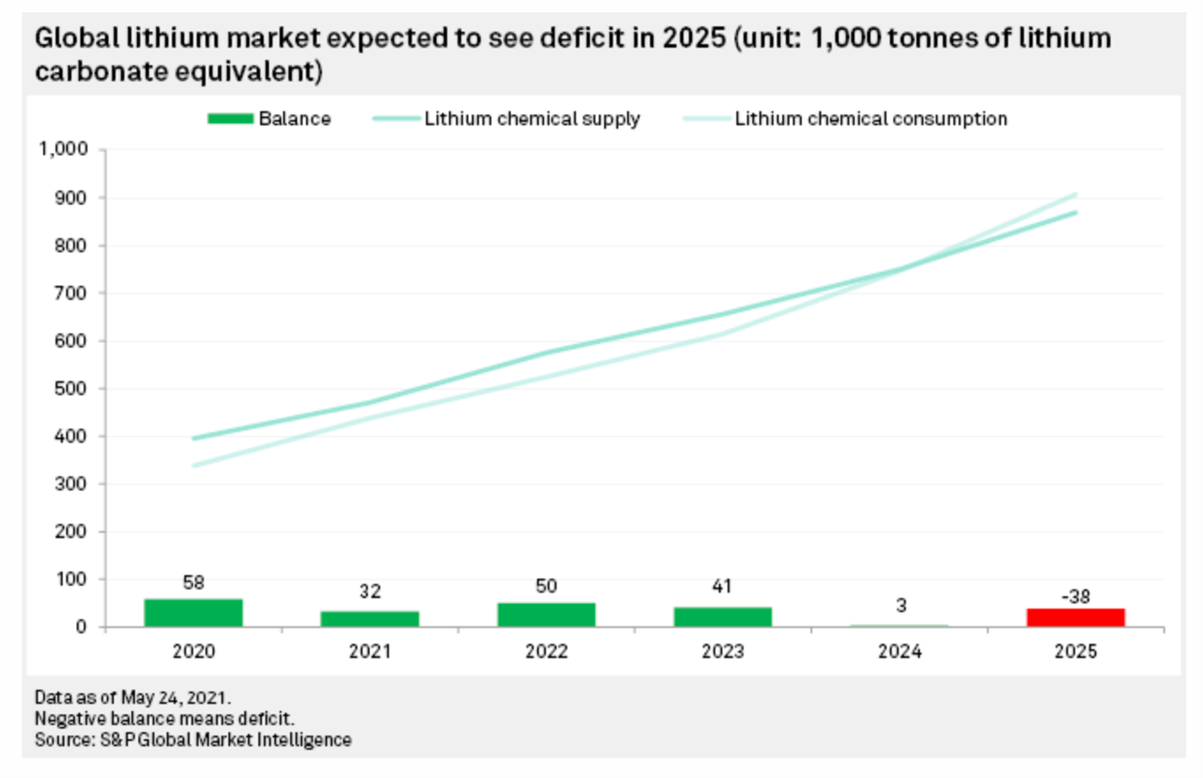
To further understand this growth, a report by Reuters stated that EV sales skyrocketed from less than 1% of the market share in 2010 to 54% of the market share in 2020. The market expansion is so considerable, that an estimated 84% of all lithium produced by 2025 will be consumed by batteries for EVs, ESS, and rechargeable batteries, indicating that supply chains are due to fall under mounting pressure.
As pressures loom, companies have been seeking ways to maximize their supply response and improve the life cycle of lithium-ion batteries. Producing a battery supply chain in the form of recycling, has been coined as an innovative solution to not only achieving net-zero targets, but to also help ease supply chain bottlenecks. According to The National Blueprint for Lithium Batteries produced by the United States Energy Department, the recycling of lithium-ion cells not only diminishes constraints levied by materials scarcity and boosts sustainability, but it also encourages a more reliable and durable supply chain.
S&P Market Intelligence also stated that due to the world’s largest EV consumers, predominantly Europe, China, and the U.S. not being key manufacturers of lithium, an established recycling lithium-ion battery system could potentially lower the reliance on imports by generating a naturally circular domestic secondary supply chain, which will remain unaltered in the face of international shortages.
Some of the largest lithium producers
Australian mining companies have taken particular notice in lithium, causing the country to rise as one of the most foremost producers of what they have deemed to be a critical mineral.
Pilbara Minerals (ASX: PLS) is one of Australia’s key players in lithium mining, with a 100% ownership of one of the world’s leading hard rock lithium mines, The Pilgangoora Lithium-Tantalum project, in Western Australia’s Pilbara region. Pilbara Minerals is at present working on the care and maintenance aspects of a stage two development programme of the project to increase the current 2Mtpa mining and processing operation to a 5Mtpa operation.
The lithium market and battery technologies are also on the rise in China, with Chinese company Jiangxi Ganfeng Lithium Ltd currently maintaining the spot as one of the world’s largest lithium metal producers in terms of production capacity. Ganfeng lithium is also reportedly planning to expand its supply capacities by building a lithium plant in Fengcheng city, Jiangxi province, China, with a proposed production capacity of 50,000tpa of LCE. This will encourage more stability and growth within the Chinese domestic market.
Over in the U.S., American company Albemarle Corporation (NYSE: MARL) operates two significant brine lithium mines, one located in the Salar de Atacama, Chile, and the other in Clayton Valley, Nevada. Albemarle Corporation also intends to invest US$30M to US$50M in order to double the current production capacities at its Nevada site by 2025, making full use of its brine water rights.
Lithium price history
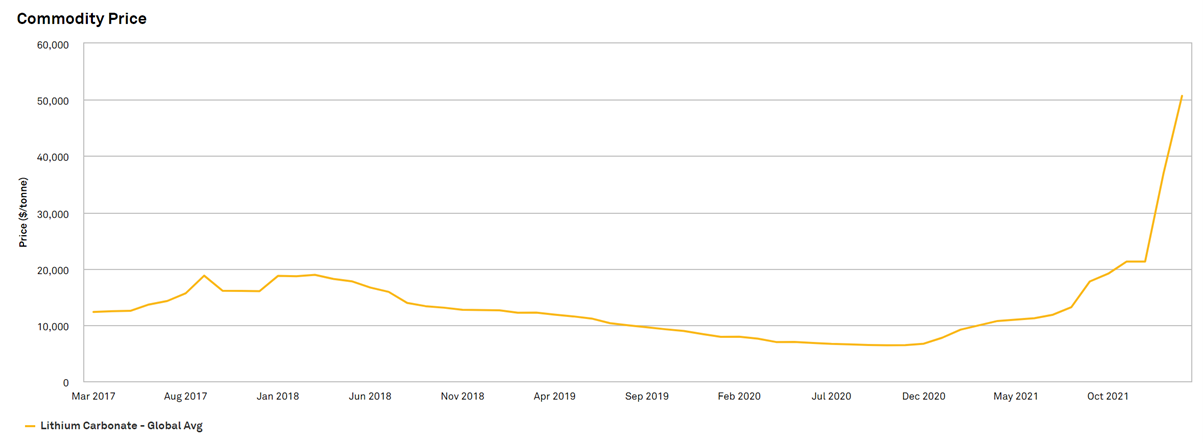
The table above, provided by S&P Global, represents the worldwide average of lithium prices over the previous five years. Throughout 2017 to December 2020 the responsive pricing of lithium experienced steady decline, which ballooned more steeply throughout 2019. According to S&P Capital, the reason for the decline was due to an oversupply over lithium chemical compounds on the market.
The adverse forecasts for lithium’s future also triggered several junior miners to revise their projects and encouraged scepticism amongst investors. S&P analysts stated in 2019 that 2020 was to be a pivotal year for the battery metal, fearing EV consumption would not increase in tandem with the flooded lithium market.
Looking at the year 2021, lithium prices rose to a significant US$21,263/t as EV uptake began to skyrocket, especially as mega companies such as Tesla started to boom in EV sales, causing demand for lithium-ion to surpass supply capacities. Even more substantial is S&P’s most recent evaluation of price per tone of lithium, reaching a staggering US$50,657 in February 2022. This extreme rise in price runs parallel to growing concerns over lithium supply chain limitations and expected unprecedent EV demand.
Lithium spot price
The combined average spot prices worldwide of Lithium as of February 28th, 2022, was US$50,657/t.
Lithium market outlook
As demand for EV’s and lithium consumption grows, Europe is expected to dominate the EV battery market, particularly considering there are ample government subsidies encouraging consumers to make more sustainable decisions. When choosing from the ever-increasing list of available EVs, battery range capabilities and pricing will be sitting at the forefront of consumers purchasing decisions. According to S&P Capital, there is speculation amongst industry leaders that nickel-rich batteries (NCM 8:1:1) will still dictate the European market due to lower price points and higher energy density within the batteries, which will allow for lengthier commutes.
Other competitive battery metal alternatives such as zinc and nickel have seen significant growth and could lead to the lithium market stabilizing over time by encouraging market balance, particularly due to the incredibly high price point being attached to the commodity in recent months. Overall, analysts predict that lithium will continue to remain in strong demand through to 2030.
Lithium price forecast
Considering all the key factors mentioned within this breakdown, the scarcity of worldwide lithium resources is set to keep market prices high. The competition from other battery metals might cause some contractors to shift to cheaper alternatives, but while major companies, such as Tesla, are leading the race to quickly source new lithium contracts to fill booming EV sales, rising prices are unlikely to knock lithium off the top spot as a critical battery metal for the future.












